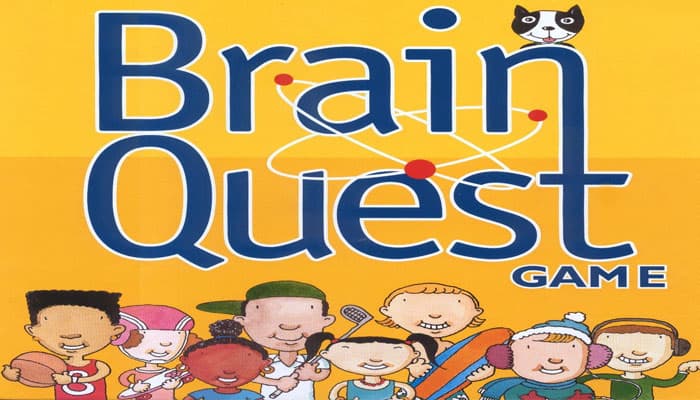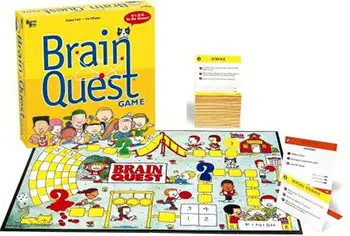

Components
- Brain Quest Game Board
- 256 Cards
- 4 Playing Pieces
- 1 Die
- Instructions
Object of the Game
To be the first player to reach Finish; players race along the path by correctly answering questions.
Parents' Summary of Rules
To start the game, the youngest player rolls the die. The player on the youngest player's left becomes the Reader for this turn. The Reader picks a card and announces the category at the top of the card.
The youngest player chooses a grade level equal to or greater than his/her current grade level (for the purposes of this game, players who are between grades are in the grade that they just completed).
The Reader reads the question from the chosen grade level, and the youngest player answers.
If the youngest player answers correctly, s/he moves his/her playing piece the number of spaces rolled on the die plus the number of grade levels above his/her grade level (if any) for the questions.
For example, fourth graders who roll a 2 and answer a sixth grade question correctly move 4 spaces (2 for the die roll plus 2 for answering a question two grade levels higher than their current grade).
If the youngest player answers incorrectly, s/he may not move. Play passes to the left (the player who was the Reader rolls the die, and the player to his/her left becomes the Reader for this turn). The first player to reach Finish is the winner.
Setup
-
Each player chooses a playing piece and places it at Start.
-
Questions are printed on the side of the cards with yellow bands at the top; answers are printed on the side with red bands.
-
Shuffle the cards.
-
Fold the Brain Quest cards in half so that the questions (yellow side) face out.
-
Place a pile of Brain Quest cards on the side of the game board. Place the extra cards back into the box.
-
Players should sit around the board according to their ages. The youngest player should sit down first, then the second youngest player should sit on the youngest player's right, etc.
The oldest player should end up on the youngest player's left. This seating arrangement will allow players to read questions close to their own grade levels.
-
Suggestion: Have pencils and paper available, particularly for some of those pesky Math questions!

Game Play
The youngest player ("Player") starts by rolling the die. The player on the youngest player's left will be the "Reader" for this turn.
The Reader picks up the top card and reads aloud the subject at the top (English, Math, Science, Social Studies, or Grab Bag). Readers should pinch cards shut so that the answers are hidden inside the cards.
Choosing a Question
Each card has six questions on it, one for each grade level in the game (1-6). After hearing the subject, the Player announces a grade level equal to or greater than his/her current grade level.

Players earn a bonus for answering questions from grade levels higher than the grade they are in (please see Moving and Bonus Points, below). Players may not choose a grade level lower than their current grade.
During the summer, Players' grade levels are the grades that they just completed. Sixth graders, and players who have completed sixth grade, may only answer sixth grade questions.
After the Player picks a grade level, the Reader reads the question from that grade level on the card. The Player answers the question, and the Reader announces whether the answer is correct or incorrect.
If Players give incorrect answers, Readers should announce the correct answers. Answers are printed inside the cards.

Moving and Bonus Points
When Players answer correctly, they move their playing pieces the number rolled on the die plus a Brain Quest Bonus of one space for each grade level above their current grade.
For example, a third grader who rolls a 4 and correctly answers a sixth grade question moves seven spaces on this turn (4 from the die plus one extra space for each grade above third grade). Sixth graders may not earn Brain Quest Bonuses.
Players must move the full number of spaces they earn on each turn (exception: please see FINISH, below). Player's turns are over after moving.
Players may not move when they answer incorrectly, and their turns are over.
Players who have completed sixth grade
Players in junior high school may only answer sixth grade questions, and they must subtract 1 from each die roll. Players who have completed junior high may only answer sixth grade questions, and must subtract 2 for each die roll.
Players who subtract from a die roll and end up with 0 or a negative number lose their turn.
Continuing Play
When a Player's turn is over, the Reader becomes the new Player. The person on the new Player's left becomes the new Reader.

Track
When Players reach the track, they move their playing pieces along the lanes of the track that have the same number as their grade levels. For example, all first graders will move along the track marked "1".
The Mud Puddle
Players who end their turn on the mud puddle space at the end of the track lose one turn. Players may only lose one turn per game in the mud puddle. Players still serve as Reader while they are in the puddle.
Foursquare
Players must move through the foursquare portion of the board in numerical order, starting at space 1.
End of the Game
The first person to reach Finish wins the game.
Players may stop on Finish even if they have more spaces left to move (this is the only time that Players may move less than the full amount of the spaces that they earn).
Tips for Reading Questions

There are two types of questions in the game that Readers should take special care in reading: questions that include an underlined space (____) and questions that
have the letters in dashes between them (for example, M-r-s).. Players fill in missing words for questions with an underline space; Readers should say "blank" whenever the underlined space appears so that Players will know where the missing words belong.
Questions that include letters with dashes usually deal with spelling; when Readers see dashes, they should say each letter separately.
Finally, our special Peek and See Cards are designed so that Readers can play along too - so don't peek!
Continue Reading


